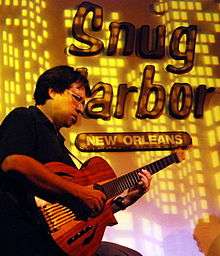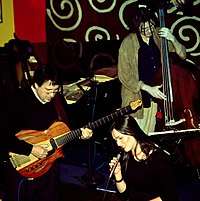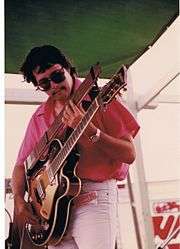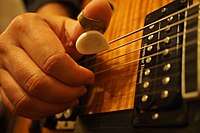Steve Masakowski
Steve Masakowski (born September 2, 1954) is jazz guitarist, educator, and inventor. He did not invent the guitar-based keytar but did invent the switch pick and has designed three, custom-built seven-string guitars. He developed an approach to playing the guitar by using his pick design, allowing him to switch from fingerpicking to flatpicking.
Steve Masakowski | |
|---|---|
 | |
| Background information | |
| Birth name | Stephen Alphonse Masakowski |
| Born | September 2, 1954 New Orleans, Louisiana, U.S. |
| Genres | Jazz, jazz fusion, Afro-Cuban, Brazilian |
| Occupation(s) | Musician, educator |
| Instruments | Guitar, keytar |
| Years active | 1970s–present |
| Labels | Blue Note |
| Associated acts | Astral Project, Masakowski Family |
| Website | www |
He has released solo albums and has worked with Johnny Adams, Mose Allison, Dave Liebman, Ellis Marsalis, Jr., Carl Fontana, Rick Margitza, Bobby McFerrin, Nicholas Payton, Dianne Reeves, Sam Rivers, Woody Shaw, Alvin Tyler, and Bennie Wallace. Since 1987, he has been a member of the band Astral Project.[1]
He has been voted Best Guitarist twice and included as a member of Astral Project in the Best Contemporary Jazz Group three times by Gambit and Offbeat magazines in their annual readers' poll. He has published lessons in Guitar Player magazine and wrote the book Jazz Ear Training – Learning to Hear Your Way Through Music for Mel Bay Publications. He has also been recognized by Down Beat magazine as Guitar Talent Deserving Wider Recognition.[2]
Career
Early life
Masakowski was born in New Orleans, Louisiana, on September 2, 1954.[3] The Beatles influenced his desire to play guitar.[4] When he was fourteen, he played bass guitar and co-founded the band Truth, which was based on the rock band Cream. In high school he became interested in composing, and he started taking guitar lessons to learn about harmony. His teacher introduced him to the music of jazz guitarists Joe Pass, Wes Montgomery, Pat Martino, and Lenny Breau.[1]
He went to the Berklee College of Music in 1974, studying music theory, arranging, and composition. After getting his degree, he returned to New Orleans with his girlfriend, jazz guitarist Emily Remler, and founded the group Fourplay (not to be confused with the later jazz group of the same name).[1] From 1976 to 1978, he studied classical composition and orchestration with Bert Braud, a teacher at the New Orleans Center for Creative Arts who also taught Terence Blanchard, Harry Connick, Jr., Branford Marsalis, and Wynton Marsalis.
Returning to New Orleans

In the early 1980s, Masakowski played regularly with local New Orleans musicians such as Earl Turbinton, Jr., Alvin Tyler, and Willie Tee. With Singleton and drummer Johnny Vidacovich, he accompanied visiting musicians such as Randy Brecker, Tom Harrell, Art Baron, and Dave Liebman. He founded the group Mars with Larry Sieberth (keyboards), James Singleton (bass), and James Black (drums). The band played a mixture of jazz and electronic music, sometimes combined with visual art created by Jon Graubarth. Dave Liebman played on the first Mars album (1983).
In 1982, Masakowski founded the Composers Recording Studio with harpist Patrice Fisher, guitarist Jimmy Robinson, and violinist Denise Villere. He often acted as audio engineer and sometimes record producer. The studio lasted about ten years and recorded Harry Connick Jr., Ellis Marsalis Jr., Tony Dagradi, the Dirty Dozen Brass Band, and pianist James Drew.
For three years, Masakowski worked in a duet with pianist Ellis Marsalis, Jr.[1][5] In 1987, he joined Astral Project. From 1993–1996, he toured with singer Dianne Reeves. He leads the band Nova NOLA, whose members include his son, double bassist Martin, and his daughter, vocalist Sasha Masakowski.[1] He released two albums for Blue Note Records: What It Was (1994) and Direct AXEcess (1995). New Orleans guitarist, banjoist, and historian Danny Barker wrote the liner notes for What It Was. When Barker died in 1994, he bequeathed his acoustic guitar to Masakowski.[1]
He was hired by Marsalis to teach in the jazz program at the University of New Orleans. In 1991, he became a full-time faculty member. After the retirement of Marsalis and a short tenure by Terence Blanchard, he became Chair of Jazz Studies and director of the jazz program in 2004.
Inventions


In 1978, Masakowski invented the key-tar, a guitar-like instrument with seven rows of keys instead of strings, one key at each fret. This pre-MIDI controller was hardwired to a Moog synthesizer. One advantage of such an instrument was that it allowed playing more than one note in a row of keys at the same time, the equivalent on the guitar of playing multiple simultaneous notes on one string. Masakowski's song "Stepping Stone" was composed on the keytar, which allowed for the cluster-type chord voicings.[3] For the duration of the Mars era, his rig included a Gretsch seven-string guitar with the keytar fastened to the top. He chose not to pursue a patent for the keytar, opting to concentrate on a revised prototype of the instrument that failed due to lack of funding.
In 1987, Masakowski invented the switch pick to help when switching from fingers to plectrum. "I invented something I call a switch-pick, which is a sort of thumb pick...[made] in such a way that if I slide it up my finger, the support part doesn't come in contact with my thumb, so it feels like a normal pick. And then if I want to use it as a thumb pick, I just slide it up my finger, and I can play finger style with the thumb pick using all five fingers."[3]
He told an interviewer, "The pick is more efficient and has a better sound on fast lines where I need swing drive, but certain ideas, like fast diatonic-fourth runs, are easier to play fingerstyle."[6]
Inspired by a visit to New Orleans by seven-string guitarist Bucky Pizzarelli, Masakowski began to explore the seven-string guitar, first finding an early Gretsch, then designing his own models which have the expanded range of a normal guitar and bass guitar combined. His custom designs were built by luthiers Jimmy Foster and Salvador Giardina.
Personal life
In 1982, Masakowski married German pianist Ulrike Antonie Sprenger. The couple have two children, both professional musicians: vocalist Sasha Masakowski (b. 1986) and double bassist Martin (b. 1990). Since 2007, the Masakowski family has been playing in bands together, including the group Nova NOLA.
In 2017, under the group name Masakowski Family, they released the album N.O. Escape, a combination of electric jazz, gypsy jazz, and vocal jazz. Steve Masakowski co-wrote three songs that were based on the novel A Confederacy of Dunces.[7]
Awards and honors
- 10 best guitarists list, Wavelength magazine (1991)
- Big Easy Award, Astral Project (1993, 1994, 2000)
- Best Guitarist (1994–1998, 2002) OffBeat magazine
- Best Contemporary Jazz Group (1994–2002), Astral Project, OffBeat magazine
- Keeping the Music Alive Award, Danny Barker Estate (2003)
- Global Excellence Award, Summers Multicultural Institute (2005)
- Germaine Bazzle Award for Music Education and Performance (2014)
Discography
As leader
| Date | Album title | Personnel | Label |
|---|---|---|---|
| 1983 | Mars | Dave Liebman, Kent Jordan, Patrice Fisher, David Torkanowsky, Larry Sieberth, James Black, Ricky Sebastian, Mark Sanders | Prescription |
| 1991 | Friends | Rick Margitza, Michael Pellera, Ellis Marsalis Jr., Bill Huntington, Herlin Riley | Nebula |
| 1994 | What It Was | Rick Margitza, Michael Pellera, Larry Sieberth, Bill Huntington, David Torkanowsky, James Genus, Ricky Sebastian, Don Alias, Hector Gallardo | Blue Note |
| 1995 | Direct AXEcess | James Singleton, Brian Blade | Blue Note |
| 1998 | Live at Snug Harbor | Earl Turbinton, Jason Marsalis, Bill Huntington, Johnny Vidacovich | Marzian |
| 2000 | (For Joe) | Bill Huntington, Johnny Vidacovich | Compass |
| 2002 | Los Tres Amigos, Moon and Sand | James Singleton, Hector Gallardo | Mirliton |
| 2009 | Nova NOLA, Wetland | Sasha Masakowski, Martin Masakowski, Ulrike Masakowski, James Westfall, Ricky Sebastian, Hector Gallardo, Scott Myers, Nick Solnick | privately published |
| 2013 | Things I Like | Rex Gregory, Peter Harris, Julian Garcia | self-release |
| 2017 | N.O. Escape | Steve Masakowski, Sasha Masakowski, Martin Masakowski, Paul Thibodeaux | self-release |
With Astral Project
| Date | Album title | Label |
|---|---|---|
| 1988 | Dreams of Love with Tony Dagradi | Rounder |
| 1994 | Acoustic Fusion | Dorn |
| 1995 | Astral Project New Orleans LA | Astral Project |
| 1997 | Elevado | Compass |
| 1999 | Voodoobop | Compass |
| 2002 | Big Shot | Astral Project |
| 2004 | The Legend of Cowboy Bill | Astral Project |
| 2006 | Astral Project Live in New Orleans | Astral Project |
| 2008 | Blue Streak | Astral Project |
As sideman
| Date | Artist | Album title | Label |
|---|---|---|---|
| 1983 | Various | Lost in the Stars: The Music of Kurt Weill | A&M |
| 1987 | Christopher Mason | Sakura | GSR |
| 1987 | Damon Short | Penguin Shuffle | Blue Room |
| 1987 | Alvin 'Red' Tyler | Graciously | Rounder |
| 1988 | Ramsey McLean & the Survivors | The New New Orleans Music: Jump Jazz | Rounder |
| 1989 | Rick Margitza | Color | Blue Note |
| 1989 | David Torkanowsky | Steppin' Out | Rounder |
| 1990 | Various | Just Friends: A Gathering in Tribute to Emily Remler Vol. 1 | Justice |
| 1990 | Mose Allison | My Backyard | Blue Note |
| 1990 | I migliori | Live at Gino's | Chromatose |
| 1991 | Various | Just Friends: A Gathering in Tribute to Emily Remler Vol. 2 | Justice |
| 1991 | Rick Margitza | Hope | Blue Note |
| 1992 | Phillip Manuel | A Time for Love | All for One |
| 1992 | Harry Sheppard | Points of View | Justice |
| 1992 | Harry Sheppard | This-a-Way That-a-Way | |
| 1994 | Tony Dagradi Trio | Live at the Columns | Turnipseed |
| 1995 | Johnny Adams | The Verdict | Rounder |
| 1995 | Denise Mangiardi | Fine Tuning | Crow Hill |
| 1995 | Betty Shirley | Unveiled | Summit |
| 1995 | Johnny Vidacovich | Mystery Street | Record Chebasco |
| 1996 | Denise Mangiardi | A River of My Own | Crow Hill |
| 1997 | Michael Pellera | Cloud 9 | Pajacis |
| 1999 | Leigh Harris | House of Secrets | Deeva |
| 1999 | Phillip Manuel | Swingin' in the Holidays | Glad-Man |
| 2000 | Phillip Manuel | Loved Happened to Me | Maxjazz |
| 2001 | Albert–Ankrum Project | Albert-Ankrum Project | Lakefront |
| 2001 | Olivier Bou | Boo-Shah-o-Ray | Olga |
| 2001 | Kevin Clark and the Crescent City Moonlighters | Big Band Music | KC |
| 2002 | Samirah Evans | Give Me a Moment | Misha |
| 2003 | Ricky Sebastian | The Spirit Within | STR |
| 2004 | Harold Battiste | Lagniappe: The 2nd 50 Years: The Future of our Past | AFO |
| 2004 | James Black | (I Need) Altitude | Night Train |
| 2004 | Phil deGruy | Just Duet | Heard Instinct |
| 2004 | Dr. John | N'Awlinz: Dis Dat or D'Udda | Blue Note |
| 2005 | Dorothy Doring | Southern Exposure | Quarter Note |
| 2005 | John Ellis | One Foot in the Swamp | privately printed |
| 2006 | Colleen Porter | Faith in New Orleans | Independent |
| 2006 | Colleen Porter | I Love My City New Orleans | Independent |
| 2007? | Mary Jane Ewing | I Love Bein' Here with You | privately published |
| 2008 | Samirah Evans | My Little Bodhisattva | Misha |
| 2008 | Sasha Masakowski | Musical Playground | self-produced |
| 2008 | TriFunctA | Hangin' | self-produced |
| 2009 | Kaya Martinez | Emergence | Polyamorous |
| 2011 | Sasha Masakowski and Musical Playground | Wishes | Hypersoul |
| 2012 | Stephanie Jordan Big Band | Stephanie Jordan Sings a Tribute to the Fabulous Lena Horne | Vige |
| 2013 | Clarence Johnson III | Watch Him Work | Like Father Like Son |
| 2014 | Charlie Dennard | From Brazil to New Orleans | self-published |
| 2015 | Mary Jane Guiney | Stay True | Moxiemuzic |
| 2015 | Irvin Mayfield | New Orleans Jazz Playhouse | Basin Street |
References
| Wikimedia Commons has media related to Steve Masakowski. |
- Yanow, Scott (2013). The Great Jazz Guitarists. San Francisco: Backbeat. pp. 129–130. ISBN 978-1-61713-023-6.
- "Down Beat 47th Annual International Critics Poll Results 1999". DownBeat. Elmhurst, Illinois. August 1999. pp. 50, 54.
- Lasocki, David (30 June 2014). Steve Masakowski, Big Easy Innovator: The Life and Work of the New Orleans Jazz Guitarist and Educator. Portland, Oregon: Instant Harmony. ISBN 978-0-9834048-5-9.
- Spielman, David G. (10 October 2012). When Not Performing. Pelican Publishing Company, Inc. pp. 90–. ISBN 978-1-4556-1756-2.
- Fumar, Vincent (4 August 1989). "Masakowski Takes the Guitar One Step Beyond". The Times Picayune. New Orleans. p. L6.
- Ellis, Andy (December 1995). "Steve Masakowski: Baritone Bop, Midnight Blues". Guitar Player. pp. 35–36.
- Milano, Brett (8 February 2017). "The Masakowski Family, "N.O. Escape"". OffBeat. Retrieved 20 October 2017.